How to Make Zucchini Flour (also known as Amish Flour)
This post may contain affiliate links. Read my full disclosure here.
Zucchini flour is a great way to use up those overgrown zucchini, plus it’s low carb and gluten free. We’ll share how to make it and how to use it.
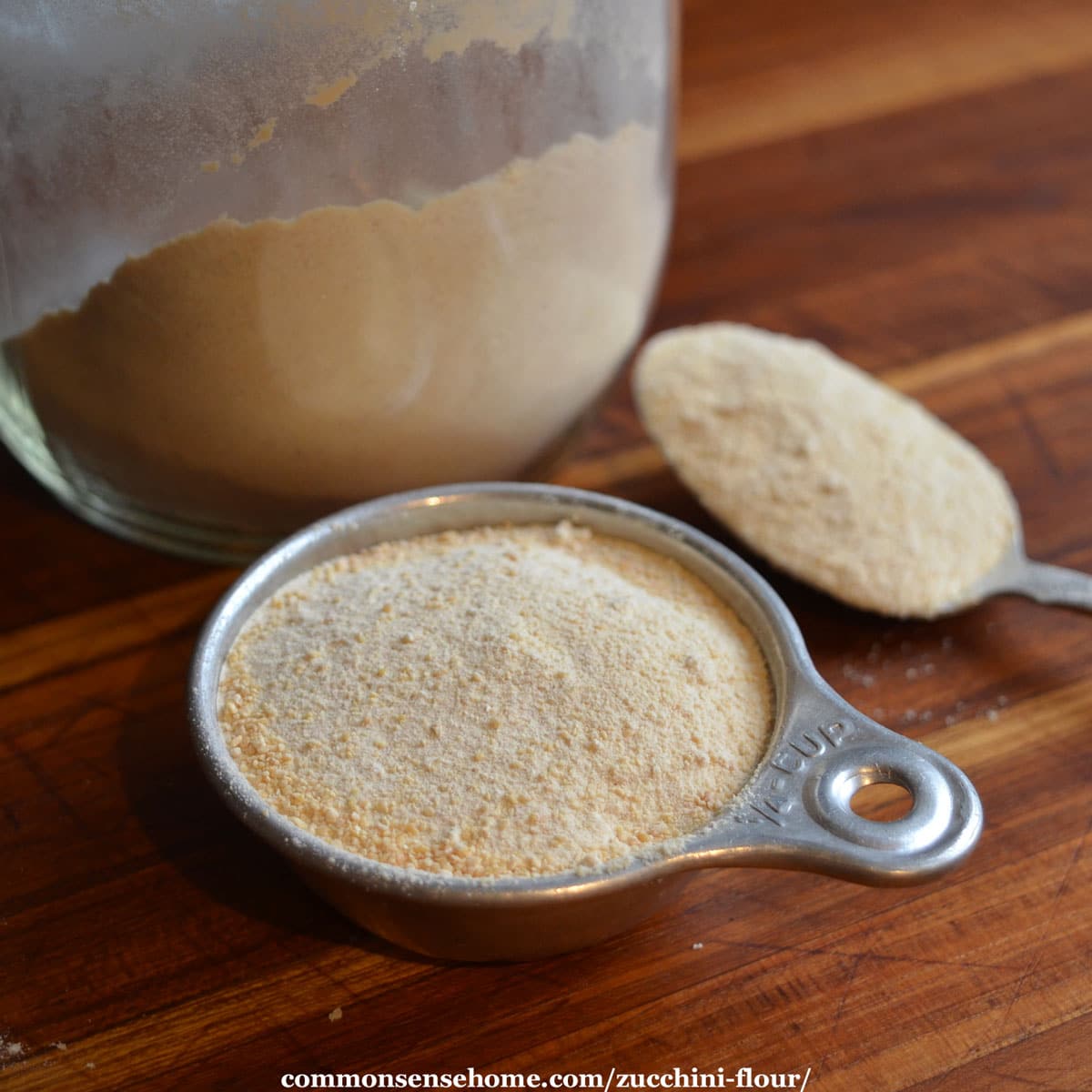
Most low carb flours are expensive, so it’s great to have an option that you can grow right in the garden. You can also use other summer squash and spaghetti squash to make squash flour. If you use a sweeter winter squash, it’ll bake a little differently.
Back in the 1940s during rationing, this flour was used to stretch wheat flour rations. It’s also more commonly used in some Amish and Mennonite communities (thus the name “Amish flour”).
For those dealing with gluten, nut, or coconut allergies, this provides an allergy friendly baking option.
How to Make Zucchini Flour
To make your zucchini flour, start with fresh zucchini. I like to use the giant, clublike zucchini, because they have a milder flavor. (These are also great for zapple pie, zapple crisp, and gummy candy.)
The big zucchini tend to have tougher skins and bigger seeds, so I normally peel and remove seeds before drying. If you use small to medium fruit, you don’t need to peel or remove seeds. The finished flour tastes more like zucchini if you use small fruit.
For fast, even drying, I shred my zucchini and squash. I run it through the shredder on the food processor, but you can also use a cheese grater. Shredded zucchini crumbles very easily when dry.
If you don’t want to shred (or don’t have a grater), thinly slice the fruit instead. Our nine tray Excalibur dehydrator holds several large zucchini once they are shredded.

Let the shredded squash drain in a colander for 15-20 minutes, then spread on mesh drying trays or fruit leather trays. Dry at 135℉ (57℃) for 8-12 hours, until zucchini is completely dry.

For oven dehydrating, set temp as low as possible and prop door open 2-6 inches. Place a fan near the oven door to improve air circulation. Spread your zucchini on a baking sheet near the center of the oven, and dry for 2 – 5 hours.
If the humidity is high or the squash is very wet, drying takes a little longer.
Once your zucchini is crispy dry, it’s time to finish the zucchini flour. Load your dried zucchini into a blender or food processor, and run on high speed until it becomes a fine powder. Let the dust settle a bit before you open the blender.
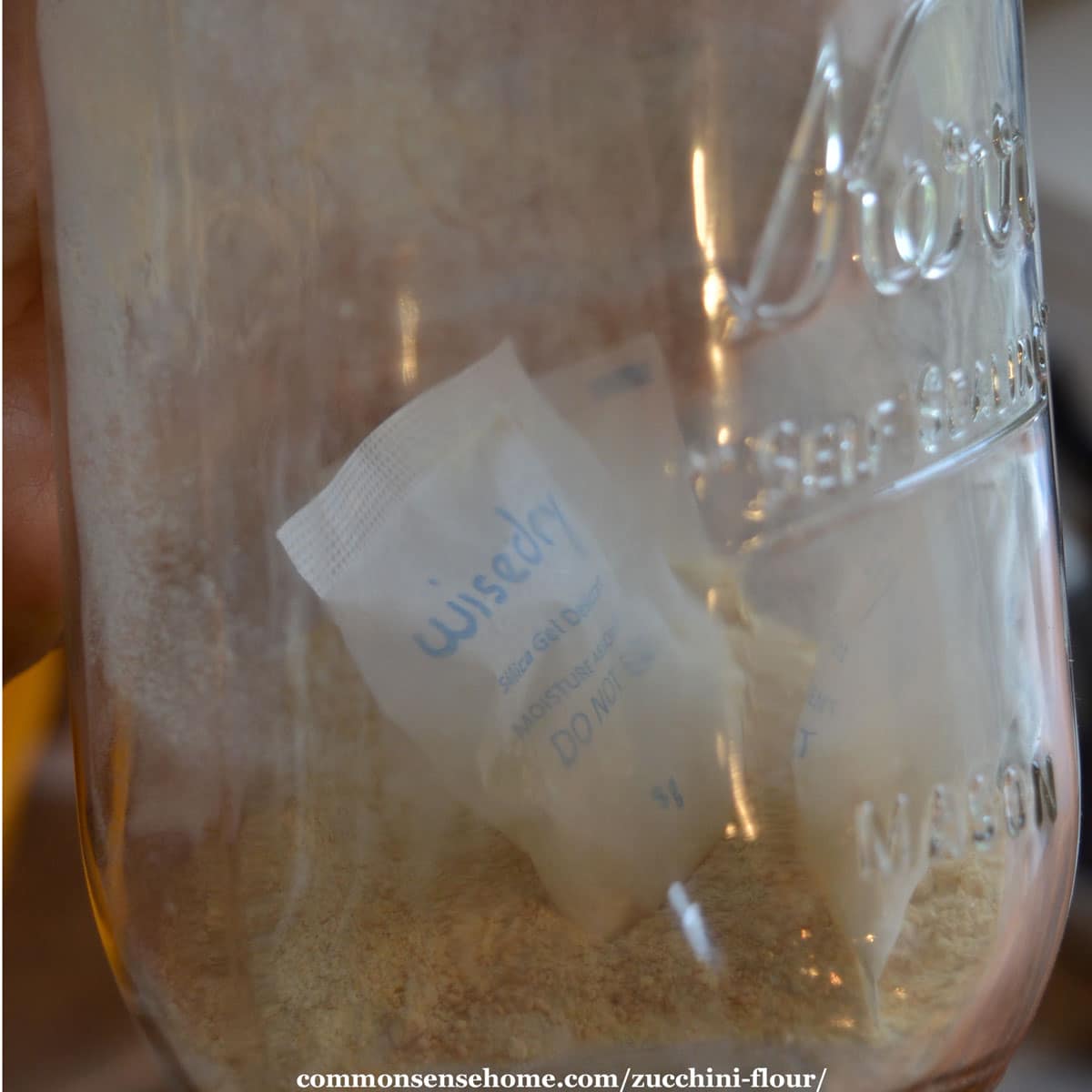
Use your flour right away, or store in an air tight container (such as a mason jar). Add a silica packet to absorb moisture. (These are the ones we use, and they can be recharged.)
Do not store the flour in the refrigerator (too much moisture) and use within 6 months for best quality.
Sometimes I shred and dry my zucchini and vacuum seal it in mason jars without powdering it. I make it into flour when I’m ready to use it.
It takes up a little more room, but the shredded zucchini doesn’t clog the vacuum sealer. (If you try to vacuum seal powder, it may clog the sealer.) It also allows me to skip the moisture absorber, and the shredded zucchini lasts a year or more.
How to Use Zucchini Flour
Zucchini flour makes a good replacement for coconut flour, and can be substituted 1:1 in recipes. It doesn’t work the same as almond flour, because it soaks up more moisture and is not as dense.
For baking, you can use up to 1/3 cup of zucchini flour per every cup of regular flour. If a recipe calls for 1 cup of all purpose flour, substitute:
Would you like to save this?
- 1/3 cup of zucchini flour
- 2/3 cup all purpose flour
Your squash flour doesn’t contain gluten, so using too much may cause a recipe to fail. Try using the flour for thickening in soups and sauces (and to get in some extra veggies). It also works for breading fish or meat.
I like to use the flour for baking recipes with cocoa, or heartier recipes like these chocolate raspberry granola cookies. Chocolate and other spices help camouflage the slight veggie flavor for fussy eaters.
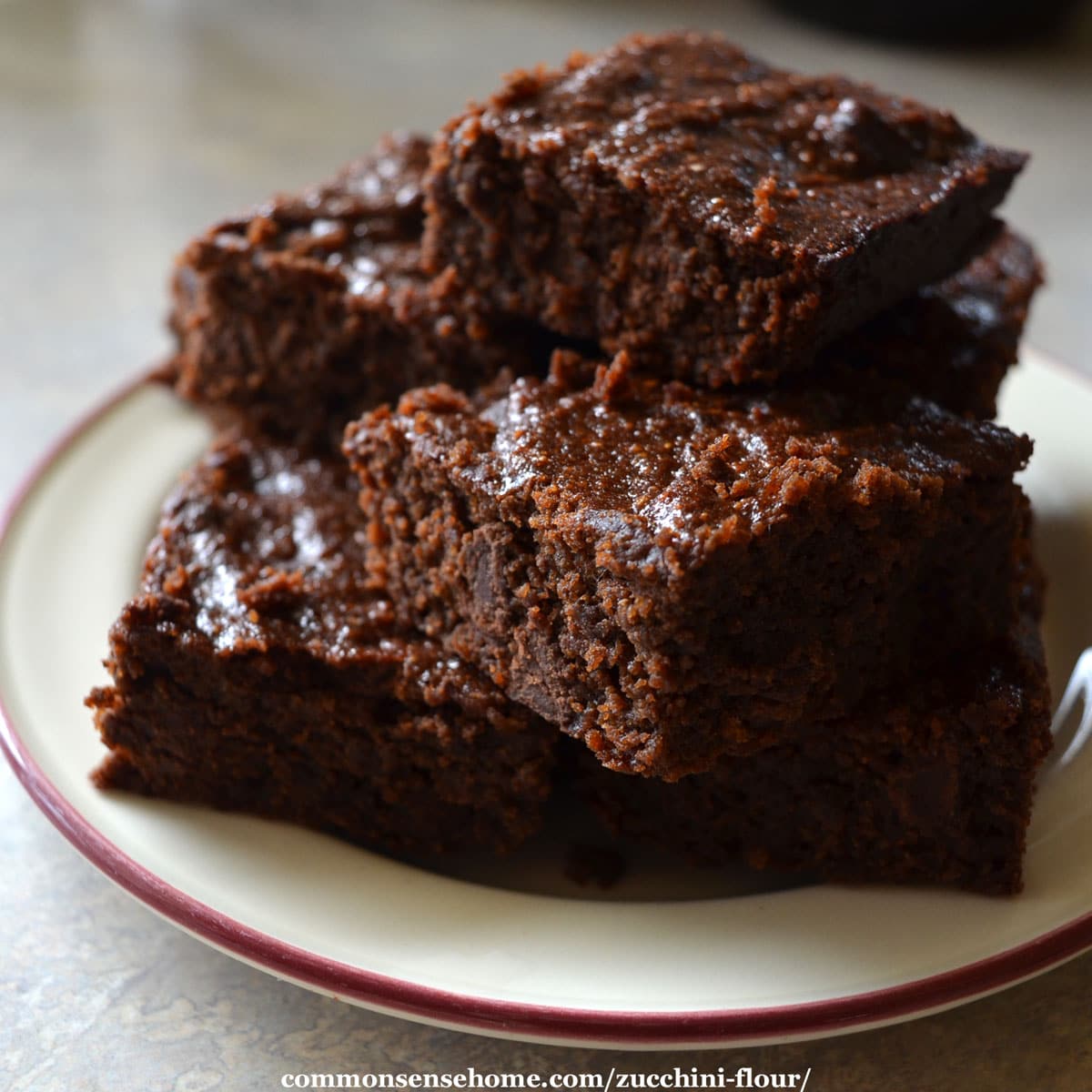
Try it in your favorite brownie recipe, or a quick bread recipe. (What goes better with zucchini bread than more zucchini?)
How Much Flour Can You Make?
Zucchini is about 90% water, so dehydrating shrinks it up by a LOT. After drying, 2 cups of shredded zucchini dries down to less than 1/2 cup of flour.
That said, a little flour goes a long way. Most coconut flour recipes use less than a cup of flour per recipe.
Zucchini is high in vitamin C and vitamin B6. It also contains manganese, potassium, and small amounts of magnesium and phosphorus.
Print Friendly Recipe
PrintZucchini Flour
Zucchini flour makes a good replacement for coconut flour, and can be substituted 1:1 in recipes. For baking, you can use up to 1/3 cup of zucchini flour per every cup of all purpose flour.
- Prep Time: 30 minutes
- Drying time: 8 hours
- Total Time: 8 hours 30 minutes
Ingredients
1 very large zucchini
Instructions
- Wash zucchini, peel (if desired), and remove seeds.
- Shred zucchini with a food processer or cheese grater. Place in colander to drain for 15-20 minutes.
- Spread shredded zucchini on dehydrator trays and dry at 135℉ (57℃) for 8-12 hours, until zucchini is completely dry.
- Grind the dried zucchini in a blender or food processer until it becomes a fine powder. Let the dust settle a bit before you open the blender.
- Use your flour right away, or store in an air tight container (such as a mason jar). Add a silica packet to absorb moisture. Do not store it in the refrigerator (too much moisture) and use within 6 months for best quality.
Notes
For oven dehydrating, set temp as low as possible and prop door open 2-6 inches. Place a fan near the oven door to improve air circulation. Spread your zucchini on a baking sheet near the center of the oven, and dry for 2 – 5 hours.
Other Vegetable Flours
You can make other vegetable flours, too. Zucchini flour has the most neutral flavor, and you don’t need to cook the zucchini.
If you’d like to experiment, try:
- potatoes
- sweet potatoes
- winter squash
Cook the vegetables, mash and spread thin to dry, and then powder.
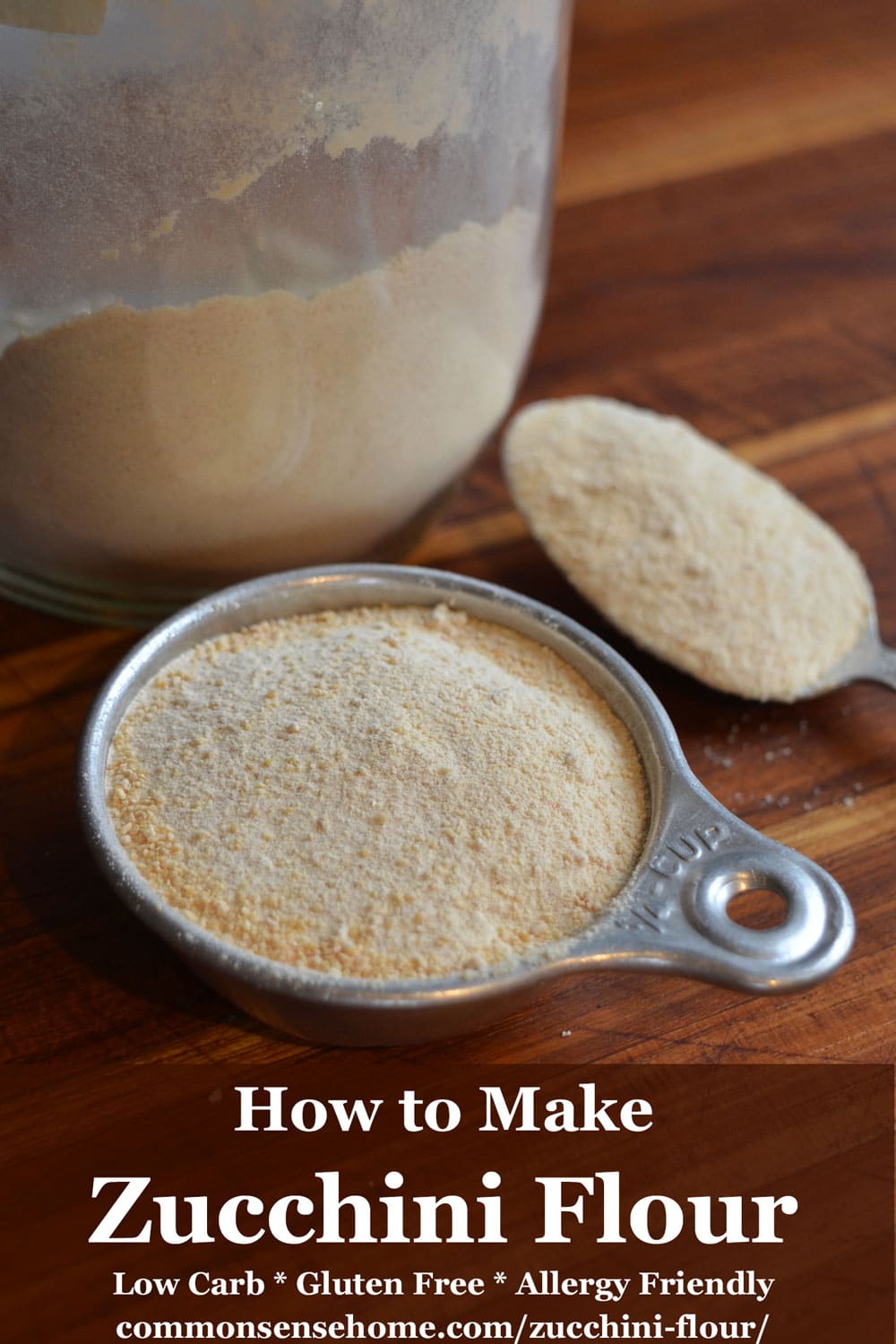

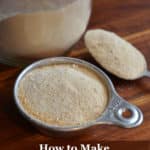
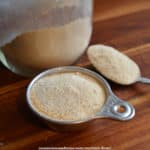
This sounds like a “grate” way to use those zucchini that get away on us. I am not crazy about coconut flour in certain recipes but have to be gluten free. Can’t wait to see if this is a good substitute. Hope we can get zucchinin plants growing again. We live in central Wisconsin and have been struggling with powdery mildew, and occasionally, dampening off the last few years. This year, it looked like we were going to be successful, but the neighbor’s chickens found they could work their way through the woods on the back side of our property and then work our yard for food. The whole flock (hens and rooster)! They are a beautiful breed, but if I would have known they were doing this before I planted, I would have put up netting. And if I would have seen the one that got into my zucchini plants, it would have been in my soup pot for supper that night.
Are you up for a road trip? I wasn’t exaggerating about bringing in armfuls of zucchini. We have more than enough.
For the powdery mildew, try calcium, potassium, and vitamin C. It’s a very common problem as the season goes on. Our plants started showing signs last week, but I’m ready for the season to wind down at this point. Also, do what you can to promote good air circulation, which is good for fungal issues, and even moisture. You might consider adding mycorrhizal fungi to the soil, as a beneficial fungi to crowd out the problem ones (like probiotics for plants). I know a lot of that area is sandy, so it may take some work to get a thriving soil ecosystem supporting your garden plants.
Thank you
Hello! Can you describe how to safely store the shredded zucchini to use later? What is the process? Thank you for this information!
Hi Alanna.
Are you talking about dried shredded zucchini?
If so, I place the dried shredded zucchini in a jar, put the flat part of a mason jar lid on, and then use the mason jar attachment for my FoodSaver vacuum sealer to vacuum seal the jar. There are also stand alone jar vacuum sealers.
You could also freeze shredded zucchini, and then take it out later, dump off excess liquid, and dry it and make the flour. The freezing process pulls some liquid out of the zucchini, so it shortens the drying time. You can learn more about home food drying and safe storage of dehydrated foods here.
I dehydrated approx 12 cups of shredded zucchini over a span of 24 hours. That’s approx 1 1/2 cups per tray, I have a 4 tray Excalibur dehydrator, at 12 hours, x2. It yielded just over 1/3 cup of zucchini flour. Be prepared for long time investment for very little return.
Zucchini is 95% water, so yes, after you remove the water, there’s not a lot left.
Finer shredding and squeezing out as much water as possible before dehydrating will reduce drying time.
Would shreaded zucchini dry faster if you used a lint free towel to squeeze the excess moisture out?
Draining in the colander takes care of a lot of excess liquid, but it certainly won’t hurt to squeeze out extra with a towel. We usually squeeze it as we load it on the trays, too.
How does the dehydrated version of the flour compare to a freeze dried version?
I haven’t yet freeze dried zucchini, since I plan to use this fairly quickly and dehydrating works fine.
A freeze dried version would be slightly drier, and should have a longer shelf life. It might make recipes a bit drier, but odds are the impact would be negligable.
Hi there just wondering. Im new to the world of dehydrators and I just bought an excalibur. If I dry grated zucchini and not powder it, how does it go added into sauces and soups? Does it rehydrate to a normal consistency or would I need to freeze dry to use it that way?
It gets close to the texture before it was dried when it goes into soups or sauces, but a little bit firmer.
PRINT please.
Can you see the version of the recipe at the bottom of the article with the numbered instructions, prep time, drying time, etc? There’s a “print recipe” button under the image in that recipe card.
Can the dried zucchini gratings be ground in a wheat grinder, electric or hand powered, in lieu of a blender or food processor? Or would it gum up the grinding stones?
If your grinder is one of the ones that can handle foods like oily nuts, it’ll probably be okay. Not sure about others not rated for messy grinds. If you want to try it, test a small amount first. The drier the zucchini and the smaller the pieces to start, the more likely it is to work.
With the finely shredded zucchini, once it dries, it easily crumbles into small bits, and those can be used “as is” for things like thickening soups. If you’re drying zucchini slices, those won’t break up nearly as easily.
i will be trying this for sure! Could you freeze this for longer storage?
Yes, freezer storage would help it last longer.
Wow! I didn’t know this information on zucchini. Thank you very much for the info. I’m so appreciative of your blog.
Many blessings to you.
Thank you for your kindness, Nina.